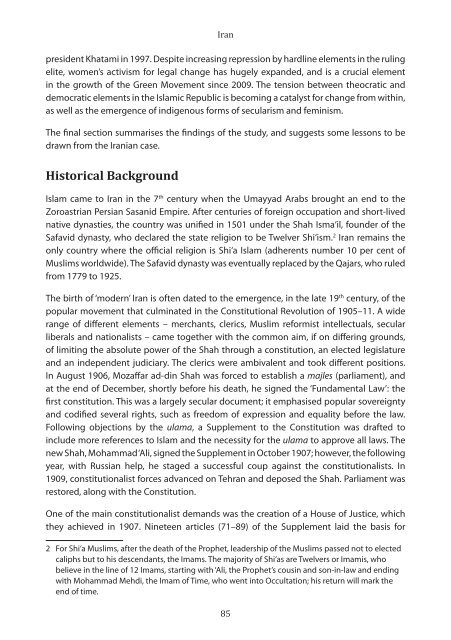control and sexuality
control and sexuality
control and sexuality
- No tags were found...
You also want an ePaper? Increase the reach of your titles
YUMPU automatically turns print PDFs into web optimized ePapers that Google loves.
Iranpresident Khatami in 1997. Despite increasing repression by hardline elements in the rulingelite, women’s activism for legal change has hugely exp<strong>and</strong>ed, <strong>and</strong> is a crucial elementin the growth of the Green Movement since 2009. The tension between theocratic <strong>and</strong>democratic elements in the Islamic Republic is becoming a catalyst for change from within,as well as the emergence of indigenous forms of secularism <strong>and</strong> feminism.The final section summarises the findings of the study, <strong>and</strong> suggests some lessons to bedrawn from the Iranian case.Historical BackgroundIslam came to Iran in the 7 th century when the Umayyad Arabs brought an end to theZoroastrian Persian Sasanid Empire. After centuries of foreign occupation <strong>and</strong> short-livednative dynasties, the country was unified in 1501 under the Shah Isma‘il, founder of theSafavid dynasty, who declared the state religion to be Twelver Shi‘ism. 2 Iran remains theonly country where the official religion is Shi‘a Islam (adherents number 10 per cent ofMuslims worldwide). The Safavid dynasty was eventually replaced by the Qajars, who ruledfrom 1779 to 1925.The birth of ‘modern’ Iran is often dated to the emergence, in the late 19 th century, of thepopular movement that culminated in the Constitutional Revolution of 1905–11. A widerange of different elements – merchants, clerics, Muslim reformist intellectuals, secularliberals <strong>and</strong> nationalists – came together with the common aim, if on differing grounds,of limiting the absolute power of the Shah through a constitution, an elected legislature<strong>and</strong> an independent judiciary. The clerics were ambivalent <strong>and</strong> took different positions.In August 1906, Mozaffar ad-din Shah was forced to establish a majles (parliament), <strong>and</strong>at the end of December, shortly before his death, he signed the ‘Fundamental Law’: thefirst constitution. This was a largely secular document; it emphasised popular sovereignty<strong>and</strong> codified several rights, such as freedom of expression <strong>and</strong> equality before the law.Following objections by the ulama, a Supplement to the Constitution was drafted toinclude more references to Islam <strong>and</strong> the necessity for the ulama to approve all laws. Thenew Shah, Mohammad ‘Ali, signed the Supplement in October 1907; however, the followingyear, with Russian help, he staged a successful coup against the constitutionalists. In1909, constitutionalist forces advanced on Tehran <strong>and</strong> deposed the Shah. Parliament wasrestored, along with the Constitution.One of the main constitutionalist dem<strong>and</strong>s was the creation of a House of Justice, whichthey achieved in 1907. Nineteen articles (71–89) of the Supplement laid the basis for2 For Shi‘a Muslims, after the death of the Prophet, leadership of the Muslims passed not to electedcaliphs but to his descendants, the Imams. The majority of Shi‘as are Twelvers or Imamis, whobelieve in the line of 12 Imams, starting with ‘Ali, the Prophet’s cousin <strong>and</strong> son-in-law <strong>and</strong> endingwith Mohammad Mehdi, the Imam of Time, who went into Occultation; his return will mark theend of time.85


